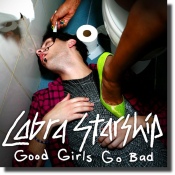Written by Gary Ewer, from “The Essential Secrets of Songwriting” website
Follow Gary on Twitter
The tonic note is the key note of your song. If your song is in Am, the note A is the tonic note. And it has a lot of power. But the more you use  it, the less influential it is. Cobra Starship, in their hit single “Good Girls Go Bad” use it barely more than once or twice. Here’s why that works so well.
it, the less influential it is. Cobra Starship, in their hit single “Good Girls Go Bad” use it barely more than once or twice. Here’s why that works so well.
The chords used in “Good Girls Go Bad” are: Am G C F. The construction of the song places the chord of Am in a strong position each time it happens: right at the beginning of most phrases. But the melody is a different story. The first notes of the verse melody are: G E D C D C E, in a descending – ascending shape. In fact, even though the chord progression emphasizes Am, the melodic structure points more toward C major. And the note A, melodically is almost nowhere to be seen.
The tonic note does actually happen toward the end of the verse, but it happens between beat 2 and beat 3, a rather weak position, and finishes with some low tonic notes. But the point here is that they are used in very uninfluential ways. Until the chorus.
And the chorus doesn’t really feature the tonic note either, until the very end, when the very last note hits a high A, andrepeats it several times.
So why does this work so well? The tonic note has a way of giving a sense of conclusion to the melody, a feeling that “we’ve arrived”. So using the tonic note too much will adversely affect the energy of the song. You may be trying to build the power of your musical lines, but every time you hit that tonic note, it feels like an arrival point. That’s why it works well as a low-pitched tonic at the end of the verse, and as a high-pitched tonic at the end of the chorus.
In your own songs, be careful how you use (and how many times you use) the tonic note. If you want to use it in unobtrusive ways, consider placing it between weaker beats in your melody in the verse, and in stronger positions in the melody.
 “The Essential Secrets of Songwriting” shows you how to write great songs. It’s just one of a suite of 6 songwriting e-books written by Gary Ewer. (His newest e-book, “The Essential Secrets of Songwriting- Chord Progression Formulas” is being offered for free when you purchase any other of his songwriting e-books.) Let these six e-books show you every aspect of how to write great songs! Read more..
“The Essential Secrets of Songwriting” shows you how to write great songs. It’s just one of a suite of 6 songwriting e-books written by Gary Ewer. (His newest e-book, “The Essential Secrets of Songwriting- Chord Progression Formulas” is being offered for free when you purchase any other of his songwriting e-books.) Let these six e-books show you every aspect of how to write great songs! Read more..










Pingback: Why aren’t you reading Gary Ewer’s blog? « Songwright